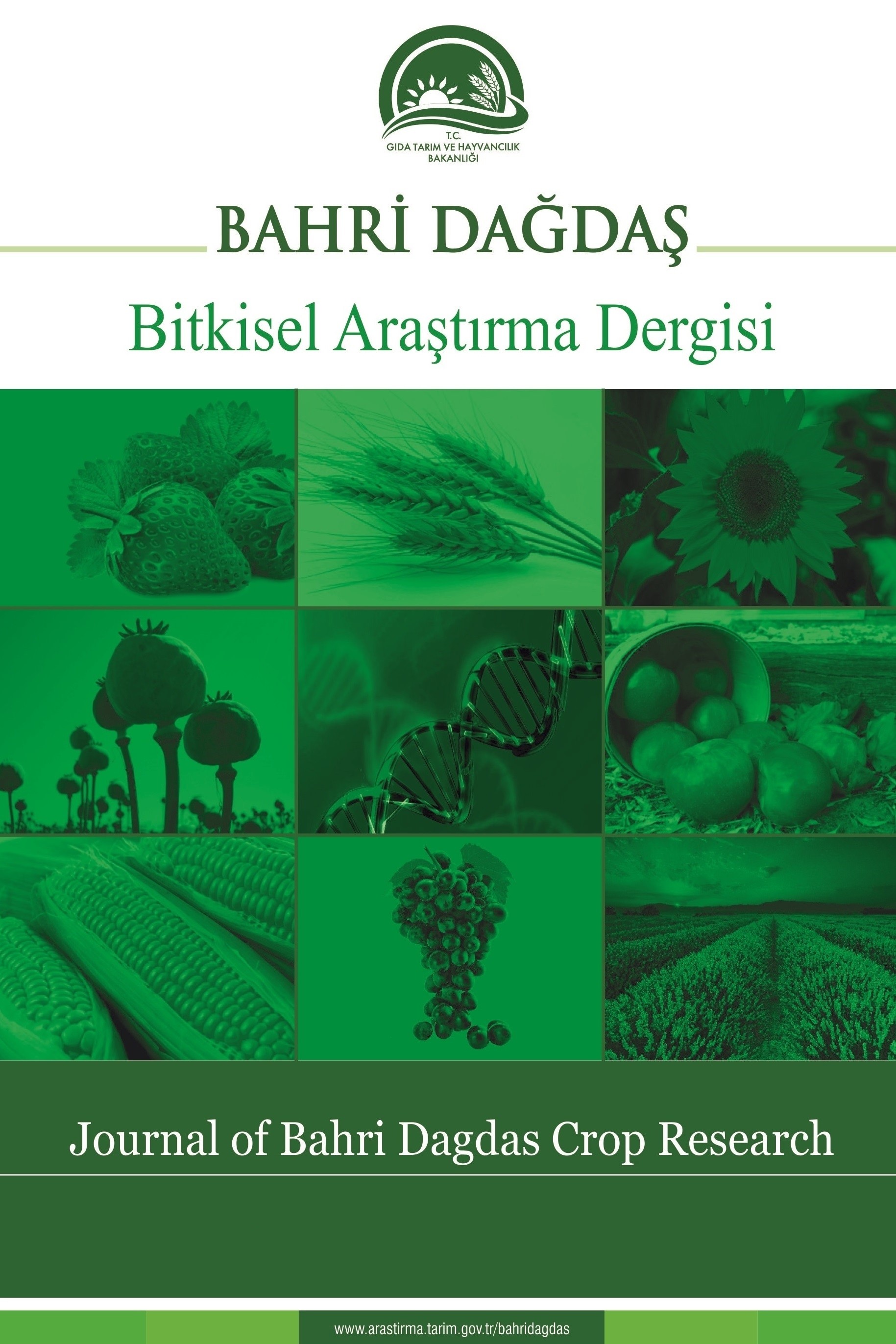In Vitro Inhibitory Effect of Some Plant Extracts Against Fusarium culmorum (W.G. Smith) Causal Agent of Foot and Root Rot Disease on Wheat
Plant extracts, Fusarium culmorum, in vitro, fungistatic activity
Buğdayda Kök ve Kök Boğazı Çürüklük Etmeni Fusarium Culmorum (W. G. Smith)’a Karşı Bazı Bitki Ekstraktlarının In Vitro İnhibitör Etkileri
Bitki ekstraktları, Fusarium culmorum, in vitro, fungistatik aktivite,
___
- Abdou I. A., Abou-Zeid A. A., El-Sherbeery M. R., Abou-el-Gleat Z. H. (1972). Antimicrobial activities of Allium sativum, Allium cepa, Raphanus sativus, Capsicum frutescens, Eruca sativa, Allium kurrat on bacteria, Qual. Plan. Mater. Veg., 22(1), 29-35.
- Bishop, C. D., Thornton, I. B. (1997). Evaluation of the antifungal activity of the essential oils of Monarda citriodora var. citriodora and Melaleuca alternifolia on post-harvest pathogens. J Essent. Oil Res., 9:77–82.
- Bhuyan, P. D., Tamuli, P., Boruah, P. (2015). In-vitro efficiacy of certain essential oils and plant extractsagainst three major pathogens of Jatropha curcas L., American Journal of Plant Scşences, 2015, 6, 362-365.
- Dulger, G., Tutenocakli, T., Dulger, B. (2015). Antimicrobial potential of the leaves of common mullein (Verbascum thapsus L., Scrophulariaceae) on microorganisms isolated from urinary tract infections, Journal of Medicinal Plants Studies, 2015; 3(2): 86-89.
- Erdoğan, O., Çelik, A., Yıldız, Ş., Kökten, K. (2014). Pamukta Fide Kök Çürüklüğü Etmenlerine Karşı Bazı Bitki Ekstrakt ve Uçucu Yağlarının Antifungal Etkisi, Türk Tarım ve Doğa Bilimleri Dergisi 1(3): 398- 404.
- Gandhi, D. N., Ghodekar, D. R. (1988). Antibacterial activity of garlic extract against lactic acid bacteria and contaminants of fermented milks. Indian J. Dairy Sci., 41: 511-512.
- Hitokoto, H., Morozumi, S., Wauke, T., Sakai, S., Durata, H. (1980). Inhibitory effects of spices on growth and toxin production of toxigenic fungi. Appl. Environ. Microbial., 39: 818.
- Knight, S. C., Anthony, V. M., Brady, A. M., Greenland, A. J., Heaney, S. P., Murray, D. C., Powell, K. A., Schulz, M. A., Spinks, C. A., Worthington, P. A. (1997). Rationale and perspectives on the development of fungicides. Ann. Rev. Phytopathol., 35, 349–372.
- Leroux, P., Gredt, M., Leroch, M., Walker, A. S. (2010). Exploring mechanisms of resistance to respiratory inhibitors in field strains of Botrytis cinerea, the causal agent of gray mold. Appl. Environ. Microbiol., 76, 6615–6630.
- Mirik, M., Aysan, Y. (2005). Effect of some plant extracts as seed treatments on bacterial spot disease of tomato and pepper. The Journal of Turkish Phytopathology, 34:9-16.
- Osman, K. A., Abdulrahman, H. T. (2003). Risk Assessment of Pesticides to Human and the Environment. Saudi Journal of Biological Science, 10, 81-106.
- Riaz, M., Zia-Ul-Haq, M., Jaafar, H. Z. E. (2013). Common mullein, pharmacological and chemical aspects, Rev. bras. farmacogn. vol.23 no.6 Curitiba Nov./Dec. 2013.
- Shetty, S. A., Prakash, H. S., Shetty, H. S. (1989). Efficacy of Certain Plant Extract against Seed-Borne Infection of Trichoconiella padwickii in Paddy (Oryza sativa). Canadian Journal of Botany, 67, 1956-1958. http://dx.doi.org/10.1139/b89-248.
- Tamuli, P., Das, J., Boruah, P. (2014). Antifungal Activity of Polygonum hydropiper and Solanum melongena against Plant Pathogenic Fungi. Plant Archives, 14, 15-17.
- Tavares, W. S., Cruza, I., Petacci, F., Júnior, L. A., Freitas, S. S., Zanuncio J. C., Serrão J. E. (2009). Potential use of Asteraceae extracts to control Spodoptera frugiperda (Lepidoptera: Noctuidae) and selectivity to their parasitoids Trichogramma pretiosum (Hymenoptera: Trichogrammatidae) and Telenomus remus (Hymenoptera: Scelionidae), W.S. Tavares et al. / Industrial Crops and Products 30 (2009), 384–388.
- Turker A. U., Camper N. D. (2002). Biological activity of common mullein, a medicinal plant. J Ethnopharmacol., 82(2-3):117-25.
- Ulke, G. (2003). Domates öz nekrozu etmenleri Pseudomonas cichorii ve Pseudomonas corrugata’nın tanısı, epidemiyolojileri ve entegre mücadelesi üzerinde araştırmalar, Doktora Tezi, Çukurova Üniversitesi, Fen Bilimleri Enstitüsü, 2003, Adana.
- Yanar, Y., Belgüzar, S., Telci, İ. (2014). Origanum, Mentha ve Lippia Türlerine ait Uçucu Yağların Botrytis cinerea ve Clavibacter michiganensis subsp. michiganensis’ e karşı Antimikrobiyal Etkisi. Türkiye V. Bitki Koruma Kongresi, 3-5 Şubat, Antalya, s. 361.
- Yıldız, N., Aysan, Y., Çınar, Ö. (2001). Effect of some plant extracts, volatile oils and compost extracts on tomato stem necrosis pathogens Pseudomonas viridiflava, Erwinia chrysanthemi and Erwinia caratovora subsp. caratovora. J. Turk. Phytopath., vol. 30, No. 3-4, 59.
- ISSN: 2148-3205
- Yayın Aralığı: Yılda 2 Sayı
- Yayıncı: Bahri Dağdaş Uluslararası Tarımsal Araştırma Enstitüsü
Serin İklim Tahıllarında Embriyo Kararması ve Önemi
Zafer Şaban TUNCA, Ali TOPAL, Yaşar KARADUMAN, Serap TÜRKÖLMEZ
Ekmeklik Buğday, Buğday Unu ve Kepek Protein Oranlarının Karşılaştırılması
Mehmet ŞAHİN, Aysun GÖÇMEN AKÇACIK, Seydi AYDOĞAN, Sümeyra HAMZAOĞLU, Berat DEMİR, Fatih ÖZDEMİR
Gül İMRİZ, Fatih ÖZDEMİR, Murat Nadi TAŞ, Eyüp BAŞER, İlker TOPAL, Birol ERCAN, Mehmet Sait KARACA
